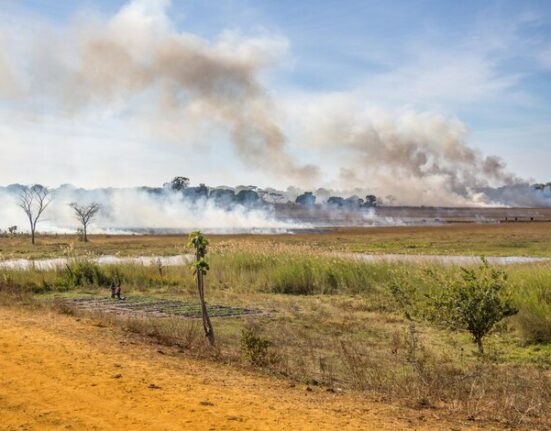Namibia, located on the southwestern coast of Africa, is renowned for its dramatic landscapes, vast deserts, and unique biodiversity. However, it is also one of the driest countries in Sub-Saharan Africa. With an arid climate, frequent droughts, and scarce water resources, Namibia has faced recurring challenges in sustaining its people, economy, and environment. This article delves into the causes, impacts, and survival strategies surrounding Namibia’s drought crisis, highlighting the resilience of its people and ecosystems.
Why Namibia Is So Dry
Namibia’s aridity is largely a result of its geographic and climatic conditions:
- Proximity to the Namib Desert
The Namib Desert, one of the oldest deserts in the world, stretches along Namibia’s western coastline. Its hyper-arid environment is shaped by the cold Benguela Current, which cools the air and reduces its moisture-carrying capacity, resulting in extremely low rainfall. - Rainfall Patterns
Namibia receives an average annual rainfall of less than 250 millimeters in most areas, with some parts of the Namib Desert receiving virtually no rain at all. Rainfall is highly unpredictable and unevenly distributed, with the northern regions generally receiving more rain than the central and southern parts. - Climate Change
Namibia is especially vulnerable to the effects of climate change. Rising temperatures and shifting weather patterns have exacerbated droughts, making them more frequent and severe.
The Impact of Drought on Namibia
Droughts in Namibia have far-reaching consequences that affect nearly every aspect of life.
1. Agriculture and Food Security
Agriculture, which employs about 70% of Namibia’s population, is heavily dependent on rain. Droughts reduce crop yields and lead to the loss of livestock, putting subsistence farmers at risk of food insecurity. Commercial farming, particularly in cattle ranching, also suffers, impacting the country’s economy.
During severe droughts, the government often declares a state of emergency, and food aid becomes a critical lifeline for rural communities.
2. Water Scarcity
Namibia’s rivers, such as the Kunene, Zambezi, and Orange, are located along its borders, leaving much of the interior without reliable surface water sources. Prolonged droughts deplete underground aquifers and reservoirs, forcing communities to rely on water trucking or unsafe sources.
Urban areas like Windhoek, the capital, face water restrictions, while rural areas often suffer from total water shortages.
3. Wildlife and Ecosystems
Namibia’s iconic wildlife, including elephants, lions, and rhinos, is not immune to the effects of drought. Reduced water and vegetation availability force animals to migrate in search of sustenance, leading to increased human-wildlife conflict. Protected areas, such as Etosha National Park, often require artificial water points to support their wildlife populations.
Drought also impacts Namibia’s unique flora, such as the quiver tree and Welwitschia plant, both of which are adapted to survive in arid conditions but are increasingly stressed by prolonged dry periods.
4. Economic Challenges
The mining sector, a major contributor to Namibia’s GDP, relies heavily on water for operations. Drought-related water shortages can disrupt mining activities, reducing production and economic output. Tourism, another key sector, is also affected as wildlife viewing and eco-tourism are challenged by the diminished health of ecosystems.
How Namibia Survives: Strategies for Resilience
Despite these challenges, Namibia has implemented innovative and effective strategies to combat drought and adapt to its arid environment.
1. Water Management Innovations
Namibia is a global leader in water recycling and reuse. Windhoek is home to one of the world’s first direct potable water reuse plants, which treats wastewater to drinking standards. This innovation has significantly eased the pressure on the city’s water supply.
Desalination is also being explored as a solution. The Erongo Desalination Plant provides water for mining operations and has potential for expansion to serve urban and rural areas.
2. Sustainable Agriculture Practices
To address food insecurity, Namibia promotes drought-resistant crops such as millet and sorghum, which require less water than maize. Farmers are also encouraged to adopt conservation agriculture techniques, including minimum tillage and soil cover, to retain moisture and improve yields.
Livestock farmers are diversifying their herds to include smaller, more drought-tolerant animals such as goats. Some have also turned to game farming, which is less water-intensive and aligns with Namibia’s eco-tourism initiatives.
3. Community-Based Natural Resource Management (CBNRM)
Namibia has pioneered a globally recognized CBNRM program, empowering local communities to manage and benefit from their natural resources. Conservancies provide incentives for sustainable land use and wildlife conservation, ensuring that communities have a stake in protecting their environment.
During droughts, conservancies help fund water points and provide alternative livelihoods, such as crafts and tourism-related activities.
4. Government and International Support
The Namibian government has established drought relief programs that provide food aid, water, and financial assistance to affected communities. These efforts are often supported by international organizations such as the United Nations and the World Bank.
Policy frameworks, such as Namibia’s Climate Change Strategy and Action Plan, aim to build long-term resilience by integrating climate adaptation into national development planning.
Lessons from Namibia’s Resilience
Namibia’s ability to survive and adapt to its drought crisis offers valuable lessons for other arid regions worldwide:
- Innovation Is Key: From water recycling to drought-resistant crops, Namibia demonstrates that technology and innovation can mitigate the impacts of water scarcity.
- Community Involvement Matters: Empowering local communities to manage their resources ensures sustainable development and reduces vulnerability.
- Climate Adaptation Is Essential: With climate change intensifying droughts globally, Namibia’s proactive approach to resilience serves as a model for integrating climate adaptation into national policies.
Namibia’s drought crisis is a stark reminder of the challenges posed by climate change and water scarcity. However, it is also a testament to the resilience of its people, ecosystems, and government. By continuing to innovate, adapt, and invest in sustainable solutions, Namibia is not only surviving but also inspiring other nations to tackle similar challenges.
As the world faces increasing environmental pressures, Namibia’s story underscores the importance of global collaboration and shared responsibility in addressing the impacts of climate change. Together, we can ensure a future where even the world’s driest regions can thrive.
Join 'Namibia Today' WhatsApp Channel
Get the breaking news in Namibia — direct to your WhatsApp.
CLICK HERE TO JOIN












